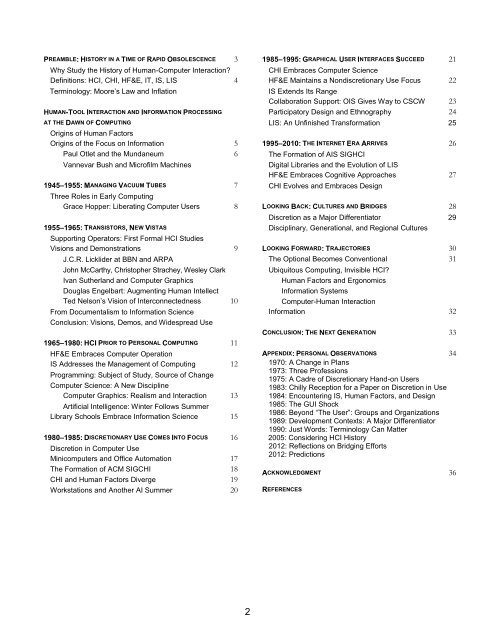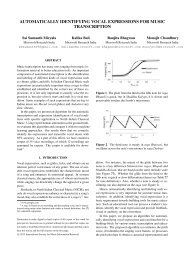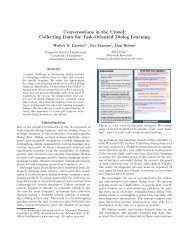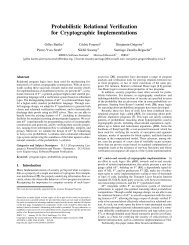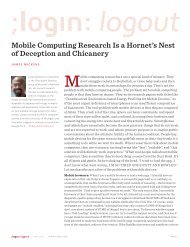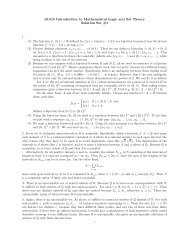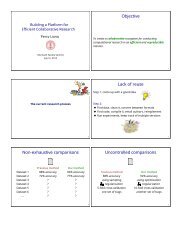A Moving Target—The Evolution of Human-Computer Interaction
A Moving Target—The Evolution of Human-Computer Interaction
A Moving Target—The Evolution of Human-Computer Interaction
You also want an ePaper? Increase the reach of your titles
YUMPU automatically turns print PDFs into web optimized ePapers that Google loves.
PREAMBLE: HISTORY IN A TIME OF RAPID OBSOLESCENCE 3<br />
Why Study the History <strong>of</strong> <strong>Human</strong>-<strong>Computer</strong> <strong>Interaction</strong>?<br />
Definitions: HCI, CHI, HF&E, IT, IS, LIS 4<br />
Terminology: Moore’s Law and Inflation<br />
HUMAN-TOOL INTERACTION AND INFORMATION PROCESSING<br />
AT THE DAWN OF COMPUTING<br />
Origins <strong>of</strong> <strong>Human</strong> Factors<br />
Origins <strong>of</strong> the Focus on Information 5<br />
Paul Otlet and the Mundaneum 6<br />
Vannevar Bush and Micr<strong>of</strong>ilm Machines<br />
1945–1955: MANAGING VACUUM TUBES 7<br />
Three Roles in Early Computing<br />
Grace Hopper: Liberating <strong>Computer</strong> Users 8<br />
1955–1965: TRANSISTORS, NEW VISTAS<br />
Supporting Operators: First Formal HCI Studies<br />
Visions and Demonstrations 9<br />
J.C.R. Licklider at BBN and ARPA<br />
John McCarthy, Christopher Strachey, Wesley Clark<br />
Ivan Sutherland and <strong>Computer</strong> Graphics<br />
Douglas Engelbart: Augmenting <strong>Human</strong> Intellect<br />
Ted Nelson’s Vision <strong>of</strong> Interconnectedness 10<br />
From Documentalism to Information Science<br />
Conclusion: Visions, Demos, and Widespread Use<br />
1965–1980: HCI PRIOR TO PERSONAL COMPUTING 11<br />
HF&E Embraces <strong>Computer</strong> Operation<br />
IS Addresses the Management <strong>of</strong> Computing 12<br />
Programming: Subject <strong>of</strong> Study, Source <strong>of</strong> Change<br />
<strong>Computer</strong> Science: A New Discipline<br />
<strong>Computer</strong> Graphics: Realism and <strong>Interaction</strong> 13<br />
Artificial Intelligence: Winter Follows Summer<br />
Library Schools Embrace Information Science 15<br />
1980–1985: DISCRETIONARY USE COMES INTO FOCUS 16<br />
Discretion in <strong>Computer</strong> Use<br />
Minicomputers and Office Automation 17<br />
The Formation <strong>of</strong> ACM SIGCHI 18<br />
CHI and <strong>Human</strong> Factors Diverge 19<br />
Workstations and Another AI Summer 20<br />
2<br />
1985–1995: GRAPHICAL USER INTERFACES SUCCEED 21<br />
CHI Embraces <strong>Computer</strong> Science<br />
HF&E Maintains a Nondiscretionary Use Focus 22<br />
IS Extends Its Range<br />
Collaboration Support: OIS Gives Way to CSCW 23<br />
Participatory Design and Ethnography 24<br />
LIS: An Unfinished Transformation 25<br />
1995–2010: THE INTERNET ERA ARRIVES 26<br />
The Formation <strong>of</strong> AIS SIGHCI<br />
Digital Libraries and the <strong>Evolution</strong> <strong>of</strong> LIS<br />
HF&E Embraces Cognitive Approaches 27<br />
CHI Evolves and Embraces Design<br />
LOOKING BACK: CULTURES AND BRIDGES 28<br />
Discretion as a Major Differentiator 29<br />
Disciplinary, Generational, and Regional Cultures<br />
LOOKING FORWARD: TRAJECTORIES 30<br />
The Optional Becomes Conventional 31<br />
Ubiquitous Computing, Invisible HCI?<br />
<strong>Human</strong> Factors and Ergonomics<br />
Information Systems<br />
<strong>Computer</strong>-<strong>Human</strong> <strong>Interaction</strong><br />
Information 32<br />
CONCLUSION: THE NEXT GENERATION 33<br />
APPENDIX: PERSONAL OBSERVATIONS 34<br />
1970: A Change in Plans<br />
1973: Three Pr<strong>of</strong>essions<br />
1975: A Cadre <strong>of</strong> Discretionary Hand-on Users<br />
1983: Chilly Reception for a Paper on Discretion in Use<br />
1984: Encountering IS, <strong>Human</strong> Factors, and Design<br />
1985: The GUI Shock<br />
1986: Beyond “The User”: Groups and Organizations<br />
1989: Development Contexts: A Major Differentiator<br />
1990: Just Words: Terminology Can Matter<br />
2005: Considering HCI History<br />
2012: Reflections on Bridging Efforts<br />
2012: Predictions<br />
ACKNOWLEDGMENT 36<br />
REFERENCES


